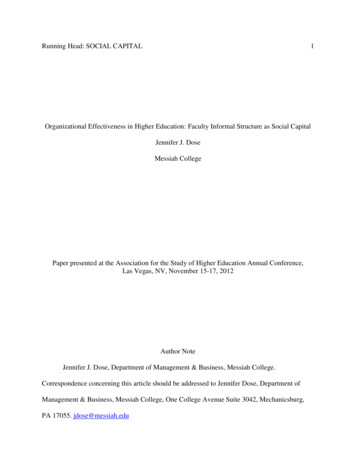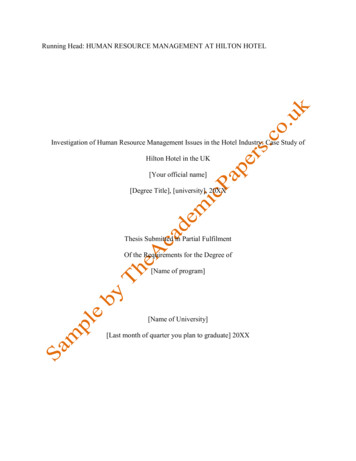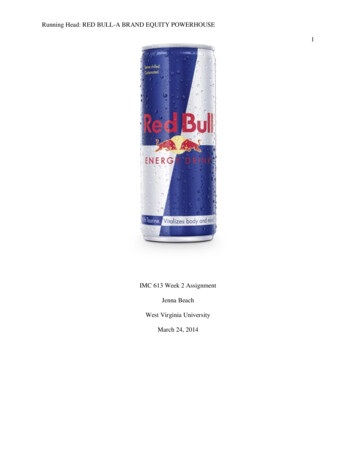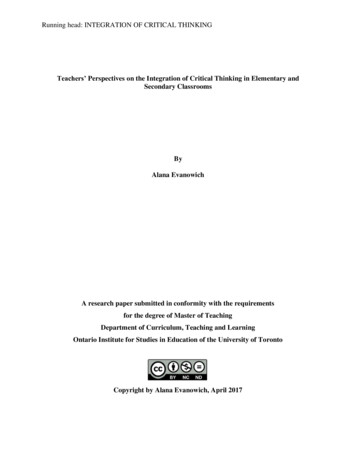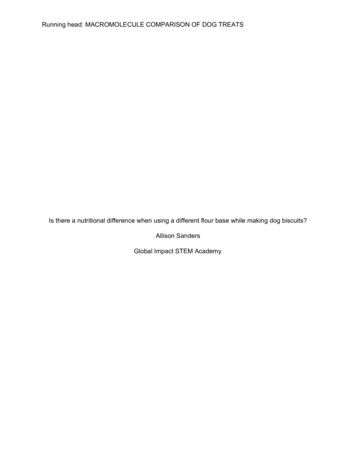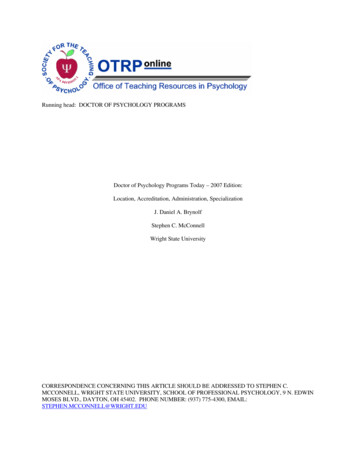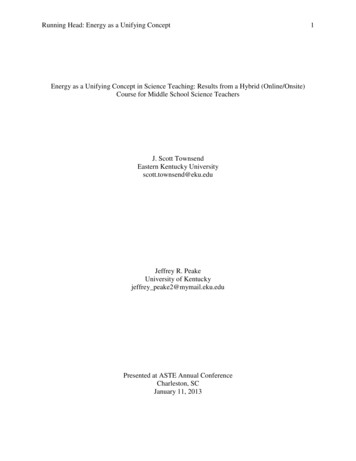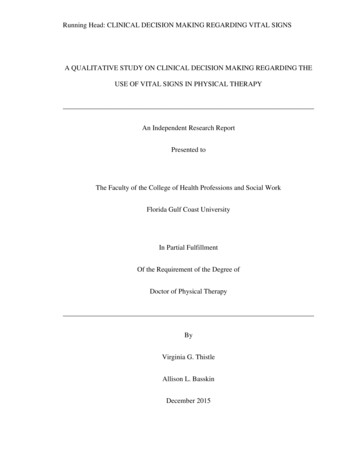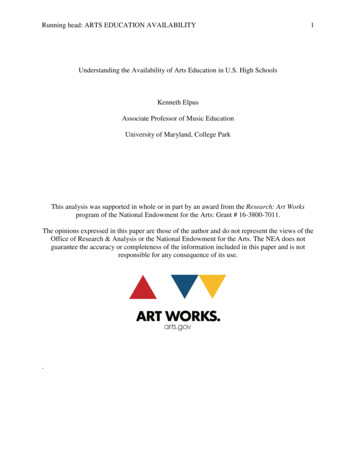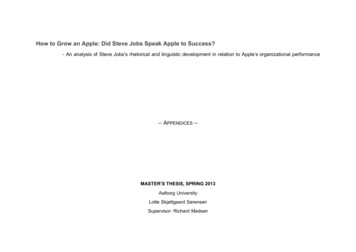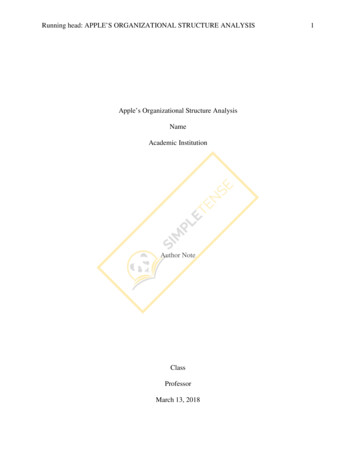
Transcription
Running head: APPLE’S ORGANIZATIONAL STRUCTURE ANALYSISApple’s Organizational Structure AnalysisNameAcademic InstitutionAuthor NoteClassProfessorMarch 13, 20181
APPLE’S ORGANIZATIONAL STRUCTURE ANALYSIS2Apple’s Organizational Structure AnalysisLehman and Haslam (2013, p. 245) claim that Apple’s organizational structure hasextensively furthered the innovation and successful performance of the firm as a technologicalcompany. The organizational structures shaped by the consecutive regimes of Steve Jobs andTim Cook have again created several opportunities for the business, ranging from innovativehuman resources practices to business expansion and product differentiation. The mechanisticorganizational structure positions leaders to be accountable for the particular functions andobjectives. The employees have minimal influence on the operational dimensions the companytakes.Apple Inc. has extensively embraced the traditional organizational structure, in which theflow of authority is channeled from defined higher hierarchies to lower ones, or subordinates(Nonala & Kennedy, 1991, p. 68). The succession of Tim Cook after Steve Jobs’s resignation ledto the revision of the organizational leadership style and structures to formulate procedures thatwould suit the dynamic market and industry demands. The decision making is relativelycentralized. The president and departmental heads sets goals to be implemented by subordinatesto ascertain the organizational efficiency. Nonala and Kennedy (1991, p. 69) reveal that the keyconcerns for Apple in regard to organizational structure are support for business performanceand conformity to rapid and inventive product and performance designs. Apple works to enhanceits capabilities to maintain technological industry dominance to increase market share andexpand possible ventures.Lehman and Haslam (2013, p. 247), assert that Cook’s oversight has completelyreinvented the performance of Apple after succeeding Steve Jobs. Cook is a liberal leader whoemploys the transformational leadership style to design the organizational structure of Apple.
APPLE’S ORGANIZATIONAL STRUCTURE ANALYSIS3The top management is completely obligated to outstanding organizational performance.Therefore, each departmental leader strives to shine their regimes. The updated structure hasthree distinct structures, namely functional, product and spoke-and-wheel leadership hierarchies.Function-Based Organizational StructureThe top influencers of Apple exhibit the function-based organizational structure. WithCook as the president, several senior vice presidents rank below him to help in the control andcoordination of organizational activities and processes. Below the president are senior vicepresidents for every functional unit. Specifically, Apple has chief design officer, senior vicepresidents in charge of finance, retail, worldwide marketing, hardware engineering, softwareengineering, Internet and software services, and industrial design (Apple Inc., 2017). The statedleaders address business needs that relate to each of their functional areas. They also function asthe chief advisers to the president. Cook then handles the overall business operations with piecesof advice or management inputs from the senior vice president who oversees the detailedfunctioning of each department.Product-Based Organizational StructureThe lower or the subordinate manager formation within Apple follows the product-basedleadership structure that embodies the divisional approach. This type of engagement mainlyfocuses on the various goods and services the organization manufactures and takes to the market.Every deputizing manager ensures that his or her line stands out effectively or performs welldevoid of challenges so that the company at large has an exceptional reputation to guaranteeorganizational success. There exist different outputs or product leaders just below the senior vicepresidents who are in charge of each division of the organizational products. Precisely, Apple hasvice presidents in charge of the iOS apps, iPad, worldwide human resources, environment, policy
APPLE’S ORGANIZATIONAL STRUCTURE ANALYSIS4and social initiatives, communications, user interface designs, dean and Apple University, andthe consumer applications (Apple Inc., 2017). This structure positions Apple as an organizationto address the specific product components the institution manufactures before launching them tothe market or responding to market or product manufacturing needs.Spoke-and-Wheel Organizational StructureApple has also embraced the spoke-and-wheel organizational structure to enable it striketo a balance in the organizational overall decision-making. Initially, before Cook took over thecompany, Steve Jobs determined every administrative function (Lehman, & Haslam, 2013,p.247). Cook introduced a more collaborative organizational style to enhance the smooth andefficient relationship between managers and employees. In consideration of the product andfunctional units within the organization, the spoke-and-wheel organizational structure enhancescollaboration between the software and hardware teams to improve productivity and creativity.With the top management’s overall planning of the organizational processes and activities, thecompany’s structure is less stiff, encouraging problem solving other than enhancement oforganizational functions.
APPLE’S ORGANIZATIONAL STRUCTURE ANALYSIS5Figure 1: Apple’s Leadership Structure (Apple Inc., 2017)Advantage of Apple’s Organizational StructureThe chain of command depicted in Apple’s organizational structure positions the topmanagement to effectively control the business. Cook and the senior vice presidents are able toexercise sturdy control over the firm as they have the departmental heads report directly to them,thereby providing primary organizational needs or information that is essential for decisionmaking and planning. The strong control of the organization is ascertained by the product-basedand function-based organizational structures.Disadvantage of Apple’s Organizational StructureThe organizational structure embraced by Cook’s leadership has a downside of limitedflexibility. The supple need to respond to the business requirements or market demands by thejunior levels of the hierarchy is imperfect. The lower tiers of workers cannot implement theentire organizational processes and the rapid emergent changes without approval from the topdecision makers. Cook and the senior vice presidents hold the final say concerning functional orproduct concerns of the organization.Conclusively, slight adjustments have been incorporated into Cook’s decision-makingprocess to improve collaboration between different organizational units, though the fullfunctionality of the procedures is not yet established. The subordinates do not have the authorityto make final judgments regarding business involvements without reporting to superiors, therebylimiting the autonomy in their positions as employees.
APPLE’S ORGANIZATIONAL STRUCTURE ANALYSISReferencesApple Inc. (2017). Apple press info. Retrieved from https://www.apple.com/pr/bios/Lehman, G., & Haslam, C. (2013). Accounting for the Apple Inc. business model: Corporatevalue capture and dysfunctional economic and social consequences. Accounting Forum,37(4), 245-248.Nonala, I., & Kenney, M. (1991). Towards a new theory of innovation management: A casestudy comparing Canon, Inc. and Apple Computer, Inc. Journal of Engineering andTechnology Management, 8(1), 67-83.6
13.03.2018 · Spoke-and-Wheel Organizational Structure Apple has also embraced the spoke-and-wheel organizational structure to enable it strike to a balance in the File Size: 848KBPage Count: 6
